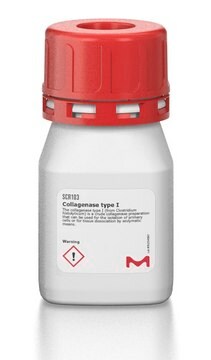1148090
USP
Collagenase II
United States Pharmacopeia (USP) Reference Standard
Synonym(s):
Collagenase from Clostridium histolyticum, Clostridiopeptidase A
Sign Into View Organizational & Contract Pricing
All Photos(1)
About This Item
CAS Number:
MDL number:
UNSPSC Code:
41116107
NACRES:
NA.24
Recommended Products
grade
pharmaceutical primary standard
manufacturer/tradename
USP
application(s)
pharmaceutical
format
neat
storage temp.
−70°C
Looking for similar products? Visit Product Comparison Guide
General description
Collagenase II is a metalloprotease that acts as an endoprotease and exhibits a tripeptidyl carboxypeptidase activity. It shows endopeptidic activity with the main cleavage site found in front of the human collagen duplex amino acids glycine-proline. Hydrolysis takes place in the interior of the triple helical domains of collagen. Collagenase II is also known as class II collagenase and consists of three subtypes: δ, ε, and ζ. Collagenase II USP reference standard is provided as delivered and specified by the issuing Pharmacopoeia. All information provided in support of this product, including MSDS and any product information leaflets have been developed and issued under the Authority of the issuing Pharmacopoeia. For further information and support please go to the website of the issuing Pharmacopoeia.
Application
- Collagenase Type II for Enhanced Cell Isolation in Biomedical Research: Collagenase Type II is extensively applied in tissue dissociation for isolating cells, crucial for regenerative medicine and tissue engineering. It enables efficient breakdown of the extracellular matrix, facilitating easier cell extraction and purification for use in 3D cell culture and stem cell research. This enzymatic method is invaluable for studies requiring high-purity cell populations, making it indispensable in developing therapies for diseases like Parkinson′s and Alzheimer′s (Park et al., 2024).
- Advancing Tissue Engineering with Collagenase II: In tissue engineering, Collagenase II plays a pivotal role by degrading the collagen matrix in tissues, thereby enabling the cultivation of cells in a controlled environment. This process is essential for constructing tissue structures from the ground up, particularly in developing organoids that mimic natural organ functionalities. The use of high-grade biotech collagenase ensures reproducibility and effectiveness in these sophisticated applications (Wu et al., 2024).
- Collagenase II in 3D Cell Culture Systems: Collagenase II is instrumental in preparing extracellular matrices for 3D cell cultures, which are critical for studying cell behaviors in environments that closely replicate in vivo conditions. This enzyme helps in the accurate study of cellular interactions and pharmacological responses, providing a more realistic assessment of cellular dynamics in medical research (Jiang et al., 2024).
- Role of Collagenase II in Stem Cell Research: Utilizing Collagenase II in stem cell research enhances the isolation and maintenance of stem cells. This is particularly important for applications where the integrity and viability of stem cells are crucial, such as in regenerative medicine and therapeutic cloning. The enzyme′s ability to gently dissociate cells while preserving their functionality makes it a staple in cutting-edge biomedical research (Simón-Pérez et al., 2024).
- Collagenase II for Effective Extracellular Matrix Degradation: The ability of Collagenase II to efficiently degrade collagen-rich extracellular matrices is utilized in various biomedical applications, including cancer research where it aids in tumor microenvironment studies and drug penetration analyses. This enzymatic activity is crucial for understanding the interactions between cancer cells and their surrounding stroma, providing insights into potential therapeutic targets (Mohamed et al., 2024).
Biochem/physiol Actions
Collagenase is activated by four gram atom calcium per mole enzyme. It is inhibited by ethylene glycol-bis(beta-aminoethyl ether) - N, N, N′,N′-tetraacetic acid, beta-mercaptoethanol, glutathione, thioglycolic acid and 8-hydroxyquinoline.
Unit Definition
One collagen digestion unit (CDU) liberates peptides from collagen from bovine achilles tendon equivalent in ninhydrin color to 1.0 μmole of leucine in 5 hours at pH 7.4 at 37 °C in the presence of calcium ions. One FALGPA hydrolysis unit hydrolyzes 1.0 μmole of furylacryloyl-Leu-Gly-Pro-Ala per min at 25°C. One Neutral Protease unit hydrolyzes casein to produce color equivalent to 1.0 μmole of tyrosine per 5 hr at pH 7.5 at 37°C. One Clostripain Unit hydrolyzes 1.0 μmole of BAEE per min at pH 7.6 at 25°C in the presence of DTT.
Analysis Note
These products are for test and assay use only. They are not meant for administration to humans or animals and cannot be used to diagnose, treat, or cure diseases of any kind.
Other Notes
This product is part of the USP Biologics program.
Signal Word
Danger
Hazard Statements
Precautionary Statements
Hazard Classifications
Resp. Sens. 1
Storage Class Code
12 - Non Combustible Liquids
WGK
WGK 1
Flash Point(F)
Not applicable
Flash Point(C)
Not applicable
Certificates of Analysis (COA)
Search for Certificates of Analysis (COA) by entering the products Lot/Batch Number. Lot and Batch Numbers can be found on a product’s label following the words ‘Lot’ or ‘Batch’.
Already Own This Product?
Find documentation for the products that you have recently purchased in the Document Library.
Customers Also Viewed
Yasin Emre Kaya et al.
Turkish neurosurgery, 30(3), 434-441 (2020-04-03)
To investigate the effects of metformin, a drug used widely for the treatment of type 2 diabetes mellitus, on human primary cell cultures prepared from uninjured segment of disc material intervertebral disk tissues. Primary cell cultures were prepared using the
Michalis Mastri et al.
American journal of clinical and experimental urology, 9(6), 416-434 (2022-01-08)
The evolving paradigm of the molecular classification of bladder cancer requires models that represent the classifications with less heterogeneity. Robust transcriptome based molecular classifications are essential to address tumor heterogeneity. Patient derived models (PDMs) are a powerful preclinical tool to
Our team of scientists has experience in all areas of research including Life Science, Material Science, Chemical Synthesis, Chromatography, Analytical and many others.
Contact Technical Service








